 |
 |
 |
| |
CASTLE Study: Pharmacokinetics and Inhibitory Quotient of Atazanavir/ritonavir 300/100 mg Once Daily Compared to Lopinavir/ritonavir 400/100 mg Twice Daily, Each in Combination with Fixed Dose Tenofovir-Emtricitabine Once Daily, Are Supportive of 48 Week Efficacy and Safety in HIV-1 Infected, Treatment-Naive Subjects
|
| |
| |
Reported by Jules Levin
9th International Workshop on Clinical Pharmacology of HIV Therapy
April 7-9, 2008
New Orleans
L Zhu, S Liao, M Child, H Sevinsky, T Eley, Y Wang, X Xu, M Mathew, D McGrath, and R Bertz
Bristol-Myers Squibb Research and Development, Princeton, NJ
AUTHOR CONCLUSIONS
Atazanavir median IQ using individual protein binding adjusted EC90 was similar to that of LPV, consistent with similar in vivo activity. These results are also supportive of the similarity in virologic suppression at 48 weeks in both arms in treatment-naive subjects
Tenofovir exposures are similar in both regimens, suggesting ATV/RTV and LPV/RTV increase tenofovir exposures to a similar extent. Overall there were minimal CrCL changes in both arms
Despite the higher RTV Cmax and similar AUC(0-24) when combined with ATV, more metabolic and GI abnormalities were observed on LPV/RTV BID than on ATV/RTV QD
BACKGROUND
-- Atazanavir (ATV) is a potent, once-daily HIV-1 protease inhibitor indicated for the treatment of HIV-1 infection in combination with other antiretroviral therapies
--In treatment-experienced patients, ATV 300 mg once daily (QD) combined with ritonavir (RTV) 100 mg compared to the standard of care lopinavir (LPV)/RTV 400 mg/100 mg twice daily (BID) were similar (non inferior) for efficacy
-- In treatment na´ve patients, the safety and efficacy of ATV 400 mg QD alone or boosted with RTV has been demonstrated in phase II and phase III studies
-- When coadministered with tenofovir disoproxil fumarate (TDF), ATV Cmin values were decreased by approximately 25% to 40%. Therefore, it is recommended that ATV 300 mg be given with RTV 100 mg when combined with TDF. Despite reductions in ATV exposures, the efficacy of ATV/RTV+TDF has been demonstrated in treatment-experienced patients
-- Both ATV and LPV increase tenofovir concentrations by approximately 30% to 35%. It is uncertain if higher tenofovir concentrations could potentiate tenofovir-associated adverse events, including renal disorders
-- The CASTLE study is a 96 week, open-label, randomized study comparing ATV/RTV 300/100mg QD to the standard of care LPV/RTV 400/100mg BID, each with fixed dose TDF-emtricitabine (TDF/FTC 300/200mg QD) in HIV-infected treatment-na´ve subjects. The primary efficacy and safety results at Week 48 of the study have been previously reported.1
- The results of an intensive pharmacokinetic (PK) assessment conducted at Week 4 in a subset of subjects are presented
OBJECTIVES
Primary:
To compare the inhibitory quotient (IQ) and assess the steady-state PK of ATV and LPV when dosed with RTV and TDF in treatment-naive HIV-infected subjects
Secondary:
To assess the differential effects of ATV and LPV on the steady-state PK of RTV and tenofovir
METHODS
International, multicenter, open-label, randomized, 96-week study in treatment na´ve HIV-1 infected subjects. Subjects were randomized into treatment arm A (ATV/RTV 300/100 mg QD) or treatment arm B (LPV/RTV 400/100 mg BID), each in combination with TDF/FTC 300/200 mg
Main Criteria for Inclusion (main study)
-- Qualifying plasma HIV RNA ≥
5000 c/mL obtained at screening
-- Men and women, ages 18 years and older
-- No prior antiretroviral therapy
-- Subjects with a calculated creatinine clearance (CrCL) < 60 ml/min were excluded
-- A total of 39 subjects (18 in Treatment A and 21 in Treatment B) participated in the intensive PK substudy
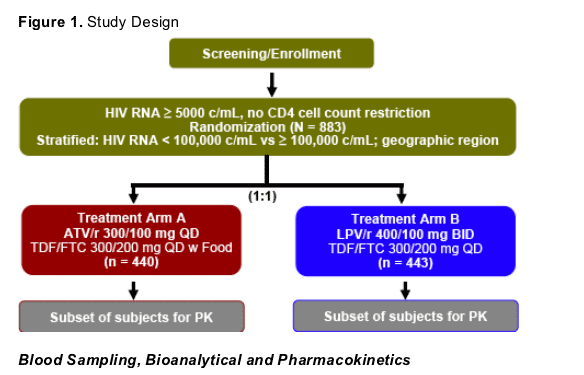
For the intensive PK substudy, serial blood samples were collected at Week 4
- Up to 24 hours for ATV, RTV, and tenofovir in treatment A
- Up to 12 hours for LPV and RTV, 24 hours for tenofovir in treatment B
Plasma samples were analyzed for ATV, LPV, RTV and tenofovir using LC-MS/MS
Noncompartmental PK were derived using a validated computer program
Inhibitory Quotient for ATV and LPV
IQ: defined as Cmin at Week 4 / protein binding adjusted EC90 values derived from clinical isolates of individual subject
Conversion of the measured baseline EC50 to protein binding adjusted EC90 as follows:
-- Protein binding adjusted EC90 (ng/mL) = sc _ mw _ EC50 (_M) / fu

*Historical /literature reported population mean protein binding adjusted EC90 values are 14 ng/mL for ATV2 and 140 ng/mL for LPV3
Statistical Analyses for PK and IQ Evaluation
An analysis of variance was performed on log transformed PK parameters (AUC, Cmax and Cmin) and IQ using treatment regimen as a factor. Point estimates and 90% CIs for differences between treatment regimens were calculated on the log scale, and were
exponentiated to obtain estimates for ratios of geometric means on the original scale
Efficacy and Safety Analyses - Main Study
Efficacy and safety analyses were evaluated through Week 48 in 883 (randomized) and 878 (treated) subjects, respectively
The principal analysis for the primary efficacy endpoint compared the proportions of subjects with HIV RNA < 50 c/mL at Week 48
between regimens using confirmed virologic response (CVR) (Non-Completers = Failure)
Safety analyses were based on the frequency of adverse events and laboratory abnormalities for treated subjects. Fasting lipid
values, changes from baseline, and percent changes from baseline are summarized through Week 48 for treated subjects
RESULTS

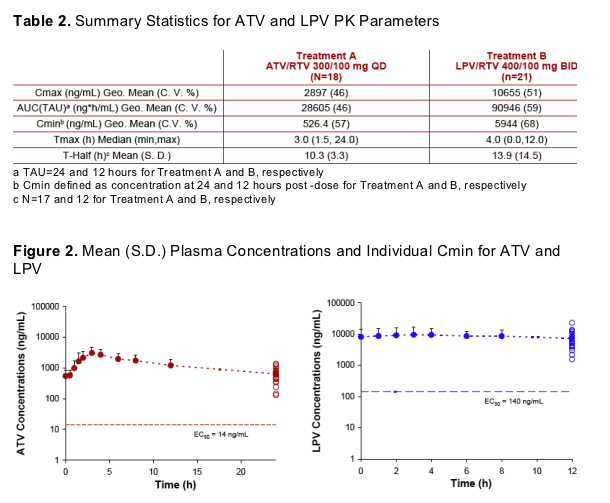
Plasma concentrations for ATV and LPV at all times during a dosing interval were well above their respective historical population mean protein binding adjusted EC90
ATV exposures in these treatment-naive subjects were largely comparable with historical data in treatment-experienced patients receiving ATV/RTV+TDF combination, but lower than historical data for patients receiving ATV/RTV without TDF
Lopinavir exposures were largely comparable (within 20%) to those reported in Kaletra USPI in healthy subjects receiving LPV/RTV + TDF
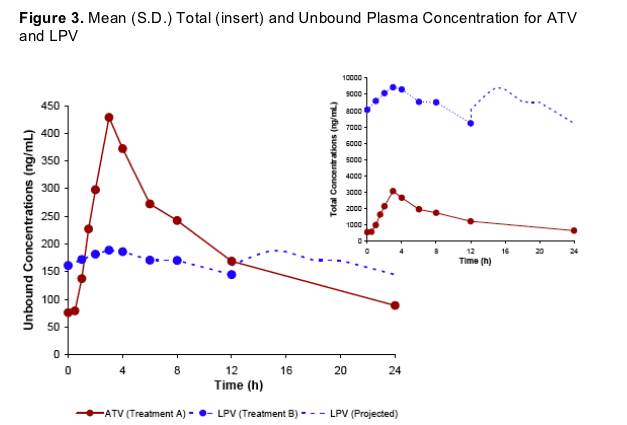
Despite maintaining a much higher total concentration level for LPV than ATV, both compounds achieved comparable estimated unbound plasma concentration levels in vivo, particularly Cmin when the plasma protein binding (assuming 98-99% for LPV and 86% for ATV) is taken into consideration
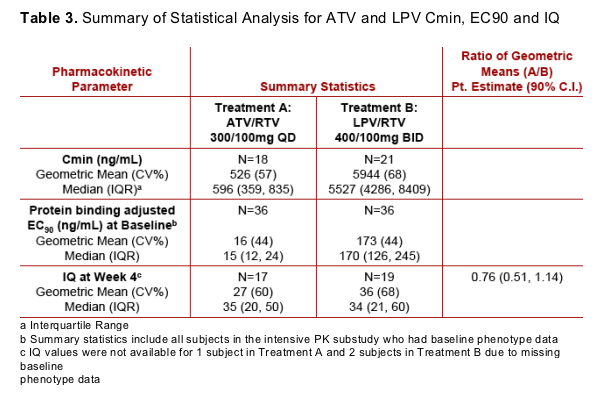
The median IQ values are similar for ATV and LPV. The geometric mean IQ value for ATV is approximately 24% lower than LPV when co-administered with RTV and TDF. Note, however, that 90% CI for the ratio of geometric means include 1 and the confidence interval is wide
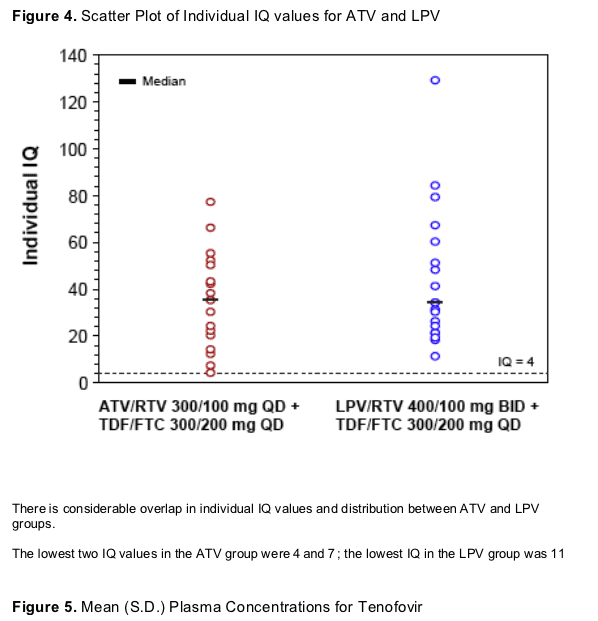
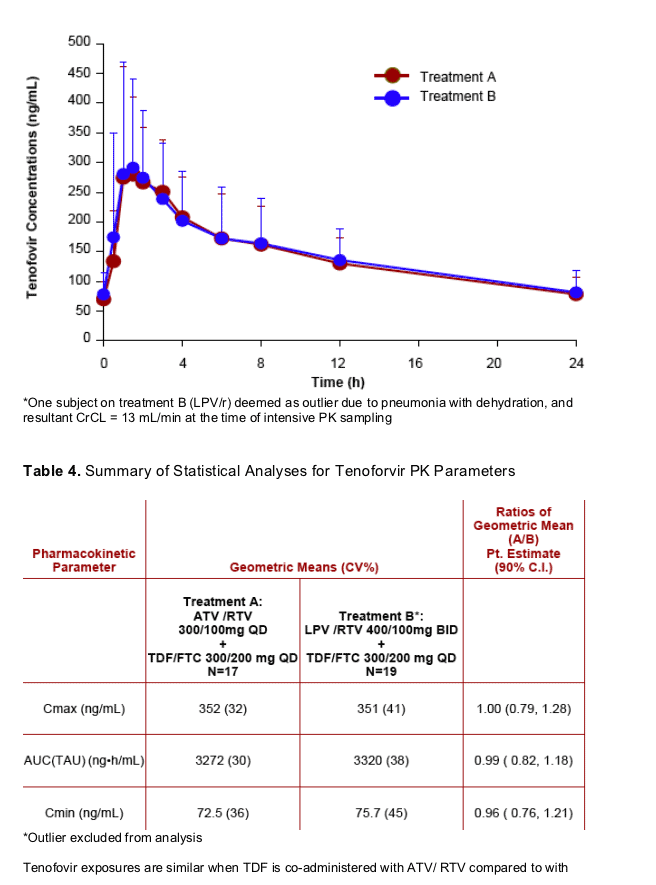
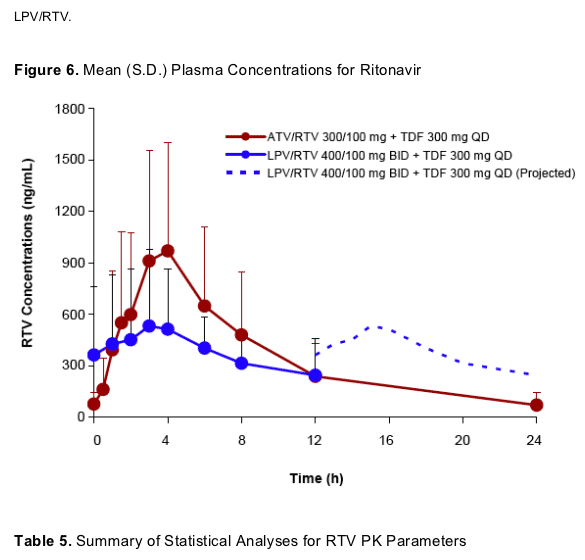
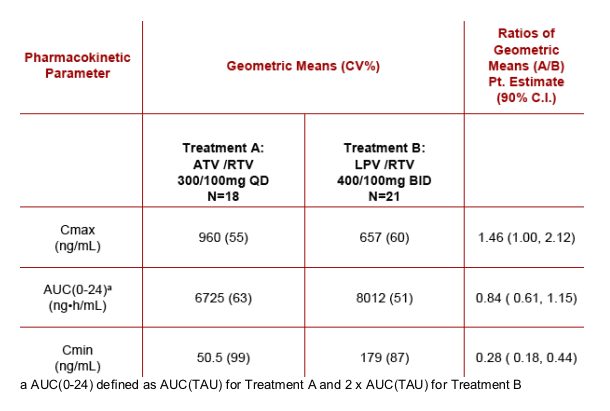
HISTORICAL RESULTS FROM CASTLE STUDY
Efficacy Results (Main Study)
ATV/RTV has similar (non-inferior) antiviral efficacy compared to LPV/RTV at Week 48, as assessed by the proportion of subjects with HIV RNA < 50 c/mL using CVR (NC = F): 78% of subjects on ATV/RTV compared to 76% on LPV/RTV (95% CI, -3.8%, 7.1%)
Safety and Laboratory Abnormality Results (Main Study)
Overall, the incidence of adverse events through Week 48 was comparable between regimens. Bilirubin-associated disorders were more common on ATV/RTV (11% vs <1% on LPV/RTV) while gastrointestinal disorders (50% vs 73%) and metabolism/nutrition (7% vs 18%) AEs were more common on LPV/RTV
Mean changes from baseline in fasting lipids (total cholesterol, LDL cholesterol, triglycerides) at Week 48 were significantly higher on LPV/RTV than ATV/RTV. At baseline, 23% and 27% of subjects on ATV/RTV and LPV/RTV, respectively, had total-to-HDL cholesterol ratio > 5; at Week 48, the rates were 12% and 20%
Mean changes from baseline in fasting glucose levels were low and comparable (2 mg/dL and 0) between regimens. The mean change from baseline in fasting insulin levels was higher on the ATV/RTV than LPV/RTV regimen (2.5 _U/mL and 0.2 _U/mL)
There was no change from baseline in the mean serum creatinine at Week 48 on either regimen. The median percent changes from baseline in the creatinine clearance (CrCL) at Week 48 were -1% on both regimens. No subjects had > 50% reduction from baseline in creatinine clearance at Week 48
REFERENCES
1. Molina Jean-Michel, Andrade-Villanueva J, Echevarria J, Chetchotisakd P, Corral J, David N, Mancini M, Percival L, Thiry A, McGrath D. Efficacy and Safety of Once-daily Atazanavir/Ritonavir Compared to Twice-daily Lopinavir/Ritonavir, Each in Combination with Tenofovir and Emtricitabine in ARV-na´ve HIV-1-infected Subjects: The CASTLE Study, 48-week Results. Presented at the 15th CROI (poster #37), Boston, 2008.
2. Description of EC50 and Conversion to Estimated Protein Adjusted EC90 for Atazanavir. Bristol-Myers Squibb Pharmaceutical Research Institute; 2003. BMS Document Control No. 930004360.
3. Murphy RL, Brun S, Hicks C, Eron JJ, Gulick R, King M, White AC, Benson C, Thompson M, Kessler HA, Hammer S, Bertz R, Hsu A, Japour A, Sun E. ABT 378/ritonavir plus stavudine and lamivudine for the treatment of antiretroviral-na´ve adults with HIV-1 infection: 48-week results. AIDS 2001;15(1):1-9.
|
| |
|
 |
 |
|
|